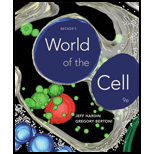
Concept explainers
What properties of the carbon atom make it especially suitable as the structural basis for nearly all
To explain: The properties of a carbon atom that make it structurally suitable as a structural basis for nearly all biomolecules.
Introduction: Carbon atom is the major component of several biomolecules. The carbon atom carrying biomolecules are diverse and stable owing to different properties of the carbon atom. Interaction of carbon with each other and with other elements is of biological importance.
Explanation of Solution
Different properties associated with carbon atom make is suitable as a structural basis for several biomolecules. The properties are mentioned below:
- Valency of 4:
The carbon atom is having a valence of 4. The carbon atom will form 4 chemical bonds with the other atoms. The carbon atom has 4 electrons in its outermost orbital. The carbon atom requires 4 more electrons to complete the octet having 8 electrons. The presence of 8 electrons in the outermost orbital provides stability to the carbon atom.
Hence, carbon binds with other 4 molecules to acquire stability. This property of carbon provides greater diversity to carbon-containing molecules in terms of molecular structure and function.
- Binding of C atom to other atoms:
The carbon atom has the capacity to bind to other molecules like sulfur, hydrogen, and nitrogen respectively. Nitrogen, sulfur, and hydrogen form an important component of several biomolecules. Nitrogen forms an important component of DNA while proteins are composed of hydrogen and sulfur.
Hence, the binding capacity of C atom with other atoms makes C atom as structurally suitable for several biomolecules.
- Asymmetric nature of the C atom:
The carbon atom is asymmetric in nature. The asymmetric nature of the C atom specifies that all the 4 atoms in the bonding are different. The carbon atom is also stable even if all 4 partners are different which is observed in diverse biological compounds.
Hence, the asymmetric nature of the C atom makes it structurally suitable for several biomolecules.
Want to see more full solutions like this?
Chapter 2 Solutions
Becker's World of the Cell (9th Edition)
- Noggin mutation: The mouse, one of the phenotypic consequences of Noggin mutationis mispatterning of the spinal cord, in the posterior region of the mouse embryo, suchthat in the hindlimb region the more ventral fates are lost, and the dorsal Pax3 domain isexpanded. (this experiment is not in the lectures).a. Hypothesis for why: What would be your hypothesis for why the ventral fatesare lost and dorsal fates expanded? Include in your answer the words notochord,BMP, SHH and either (or both of) surface ectoderm or lateral plate mesodermarrow_forwardNot part of a graded assignment, from a past midtermarrow_forwardNot part of a graded assignment, from a past midtermarrow_forward
- please helparrow_forwardWhat does the heavy dark line along collecting duct tell us about water reabsorption in this individual at this time? What does the heavy dark line along collecting duct tell us about ADH secretion in this individual at this time?arrow_forwardBiology grade 10 study guidearrow_forward
 Biology (MindTap Course List)BiologyISBN:9781337392938Author:Eldra Solomon, Charles Martin, Diana W. Martin, Linda R. BergPublisher:Cengage Learning
Biology (MindTap Course List)BiologyISBN:9781337392938Author:Eldra Solomon, Charles Martin, Diana W. Martin, Linda R. BergPublisher:Cengage Learning Human Heredity: Principles and Issues (MindTap Co...BiologyISBN:9781305251052Author:Michael CummingsPublisher:Cengage Learning
Human Heredity: Principles and Issues (MindTap Co...BiologyISBN:9781305251052Author:Michael CummingsPublisher:Cengage Learning Biology: The Dynamic Science (MindTap Course List)BiologyISBN:9781305389892Author:Peter J. Russell, Paul E. Hertz, Beverly McMillanPublisher:Cengage Learning
Biology: The Dynamic Science (MindTap Course List)BiologyISBN:9781305389892Author:Peter J. Russell, Paul E. Hertz, Beverly McMillanPublisher:Cengage Learning Anatomy & PhysiologyBiologyISBN:9781938168130Author:Kelly A. Young, James A. Wise, Peter DeSaix, Dean H. Kruse, Brandon Poe, Eddie Johnson, Jody E. Johnson, Oksana Korol, J. Gordon Betts, Mark WomblePublisher:OpenStax College
Anatomy & PhysiologyBiologyISBN:9781938168130Author:Kelly A. Young, James A. Wise, Peter DeSaix, Dean H. Kruse, Brandon Poe, Eddie Johnson, Jody E. Johnson, Oksana Korol, J. Gordon Betts, Mark WomblePublisher:OpenStax College Biology 2eBiologyISBN:9781947172517Author:Matthew Douglas, Jung Choi, Mary Ann ClarkPublisher:OpenStax
Biology 2eBiologyISBN:9781947172517Author:Matthew Douglas, Jung Choi, Mary Ann ClarkPublisher:OpenStax Principles Of Radiographic Imaging: An Art And A ...Health & NutritionISBN:9781337711067Author:Richard R. Carlton, Arlene M. Adler, Vesna BalacPublisher:Cengage Learning
Principles Of Radiographic Imaging: An Art And A ...Health & NutritionISBN:9781337711067Author:Richard R. Carlton, Arlene M. Adler, Vesna BalacPublisher:Cengage Learning





